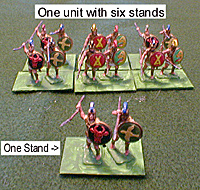 Some basic information for beginners, and frequently asked questions...
Some basic information for beginners, and frequently asked questions...
What is a stand? Unit? Command?
Figures are glued onto rectangular bases so they will stand up more easily and not tip over. The base and the figures that are on it are called a "stand." To use the scenarios on my site the rules refer to the number of stands, not the number of figures, so you can put as many figures on each stand as you like.
Under most circumstances your stands will be organized
into groups of 3 - 10, these are called units.
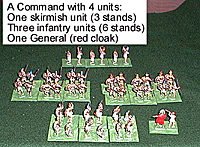 A group of units
is called a command. It's important that the students understand
that every figure on the board will really represent a large
number of men, not just one. The exact figure will depend on
the scenario, and how many figures you put on each stand.
A group of units
is called a command. It's important that the students understand
that every figure on the board will really represent a large
number of men, not just one. The exact figure will depend on
the scenario, and how many figures you put on each stand.
What is morale?
Morale, for purposes of these scenarios, is the willingness of the men to continue fighting. In some scenarios the soldiers will have to take a morale check to see if they have the courage to continue the fight. If they fail they may run away, or refuse to charge the enemy.
Why is combat so deadly?
It's important to remember that in these scenarios, when stands are removed from the battle that doesn't necessarily mean they were all killed. It only means that they are unable to continue the fight, and they may be dead, wounded, exhausted, or they may have run away.
What are skirmishers?
They are soldiers whose main function is to fire missiles (arrows, javelins, bullets, etc) at the enemy, rather than engage in hand to hand fighting. When they are forced to mix it up in close quarters they will scatter very quickly.
Why is it so hard to kill generals?
Generals did not die very often in combat, they were too valuable to risk on the front lines. So when one of them falls in battle it's a dramatic event. This also gives an unlucky player a chance to continue in the battle. All his soldiers may be gone, but his general can still be a factor.
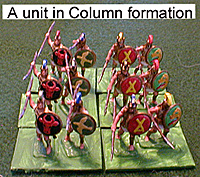 What are formations?
What are formations?
Soldiers used to fight in groups called formations. The two main types of formation in these scenarios are the column and the line.
A column formation is used to move more quickly on the
battlefield, but it makes the soldiers easy to hit with missile
fire. Imagine organizing a bunch of soldiers to march down a
road, you'd end up with a column formation - a few soldiers in
a row (any more and they wouldn't fit on the road), then another
row behind them, and so on.
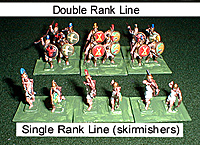 The other common formation is the
line. This formation is used for fighting, and lines can have
two ranks or one. Usually a single rank line is used for skirmishers.
The other common formation is the
line. This formation is used for fighting, and lines can have
two ranks or one. Usually a single rank line is used for skirmishers.
What companies produce 1/72 plastic figures?
The major companies producing figures right now are HaT Industries (www.hat.com/index.html), Italieri (www.italeri.com), and Imex (www.imex-model.com). Hat Industries has a terrific web site full of product information, painting guides, and much more. Lately Italieri has been selling figures designed by a Russian company, Zvezda. Imex specializes in American history. There are still a lot of figures around from companies like Revell (from Germany), Esci, Accurate, and Airfix.
Where can I get some miniatures?
Start by checking your local hobby store - the one that sells model car, airplane, and ship kits, or model trains. If they don't carry 1/72 historical figures they might be willing to order them for you. Another option is mail order and internet companies. Two companies that I often order from are The Squadron (www.squadron.com) and The Phoenix Model Company (www.phoenix-model.com).
I'd like to recreate a battle but I don't have the time to paint all those miniatures. Are there any alternatives?
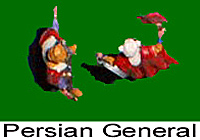
Sure. The battles look spectacular if you paint all the figures, but if you don't have time to do it there are a couple of alternatives. Often the figures are molded from different color plastics - blue for Union soldiers, gray for confederates, for example. In this case you can use them right out of the box with no painting at all - just glue them onto bases and go. If not, a couple of cans of spray paint will do the job. As long as you can tell the two sides apart the battles will work. Another option is to use paper soldiers - pictures of the soldiers glued onto cardboard bases that you can substitute for the miniatures. I'm working on a set of these for each battle.
How do you encourage good sportsmanship?
If you're a teacher then you already know hot to manage a large group of children. If you're not accustomed to gaming with a group of kids than this can seem like a daunting task. To start with, keep in mind that the students will be looking at your conduct, so model good behavior at all times. Before the game, tell them how you expect them to behave. My definition of sportsmanship includes the following: Don't gloat or taunt your opponent if you're winning, don't whine and complain when you're losing, be fair and kind to your teammates and opponents at all times. I also find that bribery is an effective tactic. I give a trophy to the student that does the best job of displaying the qualities of sportsmanship. This is usually some poor soul with abysmal luck who resists the temptation to sulk and ruin the battle for the rest of the kids. You can make a nifty little trophy by gluing an army man (the big kind) to a base and spray painting it metallic gold. Make a label on your computer, and you have a trophy that will impress the kids, and costs you a few pennies.
How do I convince my principal (or kid's teacher) to let me play a game in class?
Before I presented this idea to my principal I did some research on Magweb.com and printed out all the articles I could find about people successfully using historical miniatures with kids. If you can show that the idea has a proven track record it will help your cause. Some of the battle reports on this site could be helpful. When presenting your idea emphasis the historical and strategic elements in the game. Avoid the use of the term "war game" as this can sound insensitive to people unfamiliar with the hobby. "Hands on" lessons are popular in schools today, so you can point out that by involving the students in the battle they are more likely to remember it. If possible, set up a demonstration game and get them involved in the battle.
Did your school pay for all those miniatures?
No. I decided to buy them myself. Since they belong to me, and not the school, I feel free to use them myself for wargaming with my friends, or to loan them to others to use.
Back to Table of Contents -- Junior General Report #1
Back to Junior General Report List of Issues
Back to MagWeb.com Magazine List
© Copyright 2002 by Matt Fritz.
This article appears in MagWeb.com (Magazine Web) on the Internet World Wide Web.
Other articles covering military history and related topics are available at http://www.magweb.com